Menus
- New monster head
- Drive and driving experience
- Performance characteristics
- landing gear
- Technical data Ducati Monster 1100
- Noticed
- Our conclusion
- Comments MOTORCYCLE scoring
- MOTORCYCLE measurements
- Tech News – How It Became What It Is
- The competition
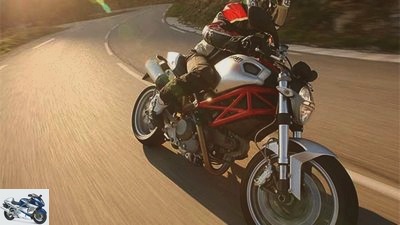
Jahn
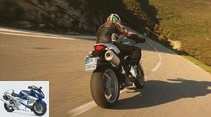
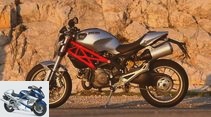
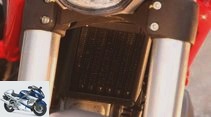

19th photos
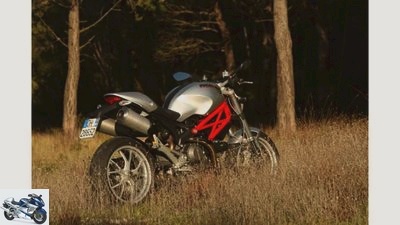
Jahn
1/19
11,200 euros have to be raised for this fascinating motorcycle. But you get a two-year guarantee, as well as an equally long extensive mobility guarantee.
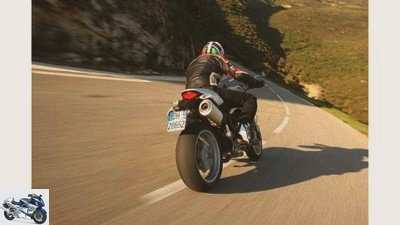
Jahn
2/19
The sound of the V2 is not unreasonably loud, but nice to hear, even when the monster is driven to the lock at 8500 rpm and a shift light warns to change gears.
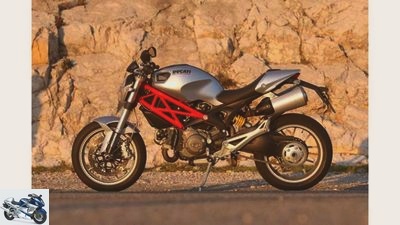
Jahn
3/19
Clear lines, neatly laid cables and lines, and no unnecessary ornamentation characterize the appearance of the monsters. Even the optically controversial front silencer under the swing arm is history.
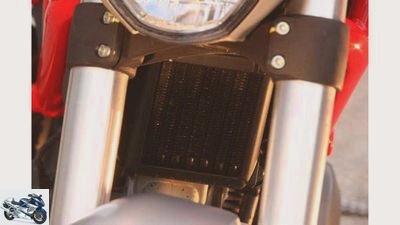
Jahn
4/19
The oil cooler is located above the horizontal cylinder.

Jahn
5/19
What for the eye! Light Marchesini rim with Y-shaped spokes.
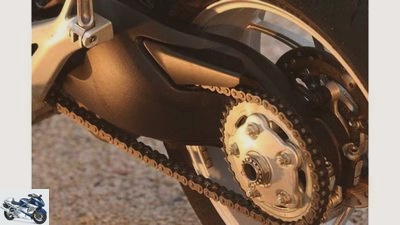
Jahn
6/19
The single-sided swing arm in the style of the superbikes is also very nice.
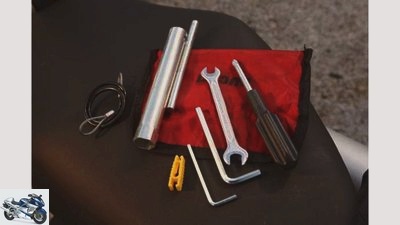
Jahn
7/19
The on-board tools are unfortunately quite meager. You will look in vain for a hook wrench to pretension the shock absorber spring or to tension the chain. In addition, the tool gets wet from splashing water when driving in the rain.

Jahn
8/19
An air-cooled, 1078cm³ V2 works in the center of the monsters. The nominal power is 90 HP, whereby the test machine was able to mobilize 7 more horses.
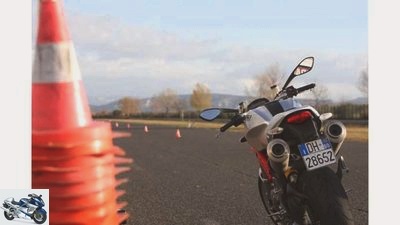
Jahn
9/19
The ergonomics of the monsters are generally good. The handlebar cranking, however, is typical of a monster and strange. A lot of the rider’s weight is on the handlebars.
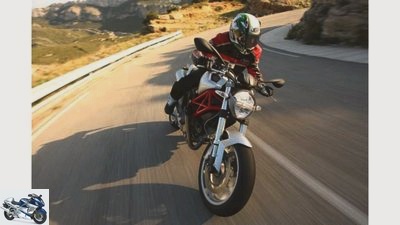
Jahn
10/19
In addition, the Monster 1100 shines with a low road consumption of 4.3 liters per 100 kilometers.
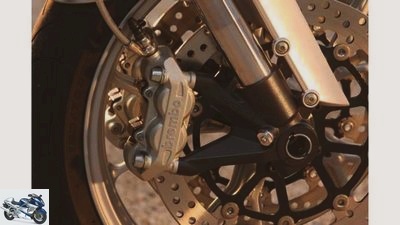
Jahn
11/19
Equipped with a radial hand pump, four-piston fixed calipers from Brembo and 320 discs …
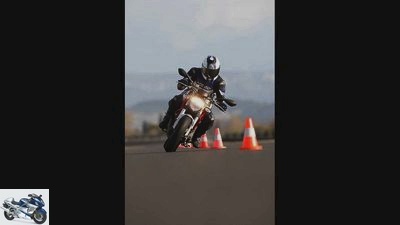
Jahn
12/19
The monsters in the pylon forest are very handy and stable. However, an unbalanced chassis set-up with a fork that tends to be a bit stiff and a comfortable shock absorber makes the Ducati react a bit wobbly when changing lean angles quickly.
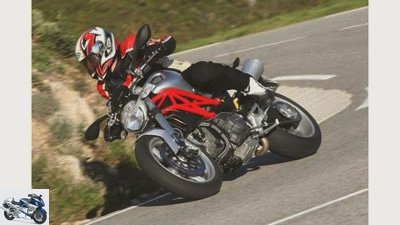
Jahn
13/19
The old-fashioned, air-cooled V2 cuts a dazzling figure. Excellent pulling power and a broadly usable speed range make you confident. Only the load change reactions and the transmission could be smoother.
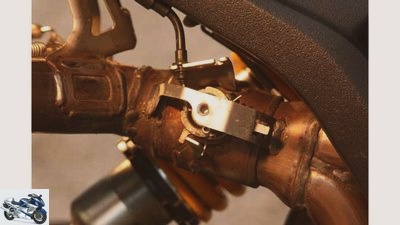
Jahn
14/19
Fortunately, the exhaust flap installed on the 1100s, along with the unsightly welds, is covered by a cover.

Jahn
15/19
Monster, that is, two-valve. Ducati recognized that too. How does the successor to the S2R, the Monster 1100, fare in the top test? More on this in the photo show.
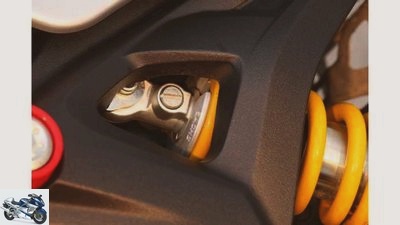
Jahn
16/19
With a longer suspension strut and longer fork tubes, the rear of the 1100 is raised by 15 millimeters compared to the Monster 696. This has a positive effect on the ground clearance and lean angle.
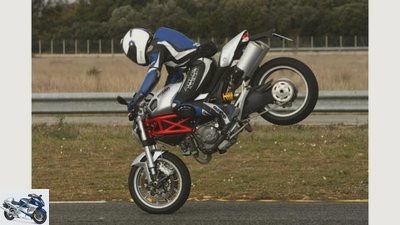
Jahn
17/19
… the Monster 1100 can be slowed down in a clean, controllable manner and with good feedback. Only violent maneuvers require a harder grip.
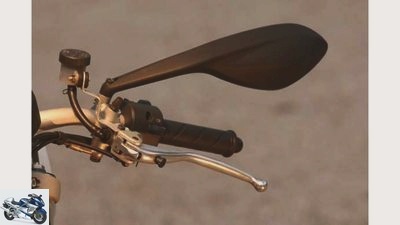
Jahn
18/19
The mirrors are also shapely, but they offer limited consideration due to vibrations.
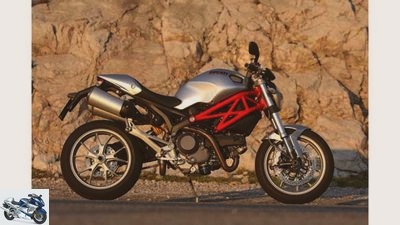
Jahn
19/19
What is noticeable first is the luminescent tubular space frame in the silver color version. With the new monster models now in connection with a bolted rear frame made of aluminum.
Top test Ducati Monster 1100
New monster head
Monster, that is, two-valve. Ducati has also recognized this and is sending the successor to the S2R to the start as the head of the family with the Monster 1100. Without water cooler, hoses and pipapo.
E.t is always an exciting moment when a motorcycle completely reinvents itself after years of construction. In the case of the Monster series, the M 696 had polished up the crumbling image with flying colors. Which, of course, only fueled the expectations of the 1100, which is visually even more attractive. She practices limiting herself to the essentials, less is more. Clear lines, neatly laid cables and lines, no superfluous ornamentation, even the always somewhat bulky front silencer under the swing arm has disappeared.
Buy complete article

Top test Ducati Monster 1100
New monster head
Ducati raised the M 1100 by 15 millimeters compared to the 696. Which is reflected in the clearance from the ground and incline as well as the seat height. If the 696 driver has to retract his feet when sharpening corners quickly in order to protect boots and toes from major injuries, the 1100 should now offer plenty of lean angle.
Drive and driving experience
Even the big Monster does not have a servo starter that cranks itself until the motor is running after a short push of a button. This ?? dispensable ?? Gimmicks are reserved for superbikes. The monster driver can get over it, because the Twin reliably starts to bullet after a short press of the button, even after a night of freezing temperatures. Incidentally, the 1100 no longer has a choke lever like the 696. The grip on the forged, adjustable clutch lever requires a little more force than with the 696, because the big Monster curiously does not have the APTC clutch, the servo function of which reduces manual forces. A dry clutch that jingles discreetly behind the closed cover ensures the frictional connection. Caution is advised on the first few meters, the ground is still frosty and cold, in the shady curves of the pass road that lies in front of us there are plenty of damp spots lurking, while the sun is still peeking tentatively over the horizon. Beads of sweat on the forehead are still within limits, although the strangely cranked aluminum handlebars do not necessarily encourage relaxed, sensitive guidance under such conditions. The weight of the rider weighs heavily on the handlebar ends. After all, the Bridgestone BT0 16 make it easy to find out what’s going on with good grip and good feedback.
In any case, you can give the engine the opportunity to flex its muscles between turns. Turn the whisk, and ?? brrooap ?? the monster slams towards the next corner with a robust thud, circling the hairpin with braked foam, straightening up and moving on. In the meantime, the sun has gained strength, the ground has risen in temperature and the damp spots are on the retreat, so slowly you can really tear off the monster. Great, this start. In any case, the big Duc two-valve engine enjoys the reputation of an excellent country road drive among connoisseurs. Logically, the Twin does not spoil the Monster either. Of course, at the lowest engine speeds it doesn’t shine with the smooth running of a three or four-cylinder engine, and nobody would seriously expect that. When switching from thrust to load, it can’t resist a significant jolt, it shakes itself noticeably under load, especially in the upper gears up to 3000 rpm, but it stomps forward with tremendous force and pressure. And if you open the gas with great sensitivity, you can reduce the load change reactions to an acceptable level. But the V2 hangs on the gas like the puppet on the rope. Every tug on the cable is immediately rewarded with a powerful, energetic drive. It is a great pleasure to let the full torque wash you from curve to curve, to call up the next gear in the somewhat hard but precise transmission and to savor the pressure from below again. Without any hassle. And the nice thing about it: This fun takes place in the legal speed range.
Performance characteristics
Jahn
Fresh look, new chassis, proven engine: Ducati Monster 1100.
Thanks to its powerful dynamics, the V2 power plant does not have to hide from much more powerful four-cylinder engines. Because the measured 97 PS are only the summit of a straight performance curve that no Ducati two-valve engine has ever painted before. In principle, the same unit as in the Multistrada and Hypermotard is at work. The same cylinders, pistons, valves and camshafts. But for the first time in a two-valve engine, the engine housing is calculated using the finite element method and, like the superbike housings of the 1198 R and 848, is manufactured using the Vacural casting process. It allows the thinnest possible wall thickness, which alone saves three kilograms in weight. And unlike the Multistrada and Hypermotard with their rather cramped airboxes, the Monster 1100 breathes its fresh air through a ten-liter part. Also new: Siemens electronics, which access a lambda probe per cylinder for control, ensure exact fuel quantities and ignition times. The result: a power and torque curve like a picture book.
This characteristic makes you relaxed, confident, because there is always enough pressure. And when the going gets tough, the Monster has an ace up its sleeve: It doesn’t shy away from higher speeds, but keeps on powering up to the locking at 8500 rpm, letting the 97 little horses mentioned gallop at full speed. The two conical mufflers play a concerto that offers everything from satisfied, grumpy banging in the lower speed range to pithy hammering when the shift light twitches hectically. The V2 is not just too loud. To tame the temperament, the same 320 brake discs and radial pliers are available as in the 696. However, these are now activated by a radial hand pump. Even with a committed pace, nothing is left to be desired. The bite sets in spontaneously, but not beastly, cleanly controllable and with good feedback. Only in the case of violent maneuvers is a stronger grip required. Then, however, the 1100 comes to a standstill a good four meters earlier from 100 km / h than the 696, in which the front tire with a 60 mm cross-section prevents peak values in the brake measurement due to the lack of self-damping with light stamping.
All of this gradually brings together the image of the uncomplicated fun-maker. Especially since the monsters are much more confident in their driving behavior than their predecessors. In terms of steering precision and neutrality, however, it does not come close to the benchmark of the 696, but reminds a little of the older monsters, who always demanded corrective counter pressure on the inside of the handlebars. This is particularly noticeable in tight or undulating curves. While the directly hinged strut adopted from the M 696 strikes a good balance between firm and comfortable, the front section appears a bit stiff in the factory setting. And the interaction between fork and shock absorber lacks harmony, especially in view of the cool temperatures. The 1100 can certainly do better. So a short stopover at the top of the pass, after all, the fork is fully adjustable. Adjusted the rebound and compression stage a strong step towards soft, and all over again.
landing gear
Jahn
Sprinting powerfully from curve to curve is the domain of the V2 and gives the M 1100 a good slalom time.
And lo and behold, the fork is already working more smoothly, the monsters slid around the corner with much more confidence. Above all, heels and ugly scars in the asphalt are now carefully ironed away. Even the MOTORRAD kickback test track, a little road studded with nasty edges and bumps, masters the monsters with decency. Don’t worry, that’s not why she’s a softie. The tuning of the spring elements is also sufficiently tight for ambitious cornering, while comfort has its place on the other hand. So the bottom line is a good mix. Especially since the fine feedback from the roadway ensures confidence even on tricky road conditions. Whirling squeaky fun over small pass roads, sprinkling in hearty intermediate sprints, the monsters make it easy for their pilot. Turns light-footed, willingly blends in with any course correction with problem-free handling, even if it is not quite as agile as its smaller sister.
This is the tribute to the wider rear tires, the larger rotating masses of the engine. The 1100 sails like clockwork through fast, curved arches. Only in tighter bends or on asphalt faults does the 1100 require a somewhat clearer directive on the handlebars, in which one ?? different from the 696 ?? recognizes their ancestors very weakly. That doesn’t diminish the enjoyment and satisfaction at the end of a day in the saddle of the monsters, especially since she doesn’t take off the last shirt of her tamer at the gas pump. The cost price of 11200 euros is not without it, is a good deal higher than the predecessor S2R. But it is clearly superior to this in all respects. And even the decommissioned, more powerful four-valve engine can be forgotten by the 1100. If that’s not a recommendation.
Technical data Ducati Monster 1100
Jahn
engine
Air-cooled two-cylinder four-stroke 90-degree V-engine, crankshaft lying transversely, one overhead, toothed belt-driven camshaft, two valves per cylinder, desmodromic actuation, wet sump lubrication, injection, Ø 45 mm, regulated catalytic converter, 520 W alternator, battery 12 V / 10 Ah, hydraulically operated multi-plate dry clutch, six-speed gearbox, O-ring chain, secondary ratio 39:15.
Bore x stroke 98.0 x 71.5 mm
Cubic capacity 1079 cm³
Compression ratio 10.7: 1
Rated output 66.0 kW (90 PS) at 7500 rpm
Max. Torque 103 Nm at 6000 rpm
landing gear
Composite frame made of steel with screwed cast aluminum parts, upside-down fork, Ø 43 mm, adjustable spring base, rebound and compression damping, single-sided swing arm made of aluminum, central spring strut, directly hinged, adjustable spring base and rebound damping, double disc brake at the front, Ø 320 mm, four-piston Fixed calipers, rear disc brake, Ø 245 mm, two-piston fixed caliper.
Cast aluminum wheels 3.50 x 17; 5.50 x 17
Tires 120/70 ZR 17; 180/55 ZR 17
Bridgestone BT 016 tires tested
mass and weight
Wheelbase 1450 mm, steering head angle 66.0 degrees, caster 94 mm, spring travel f / h 130/148 mm, permissible total weight 390 kg, tank capacity / reserve 15.0 / 3.5 liters.
Service data
Service intervals every 10000 km
Oil and filter change every 10000 km 3.9l
Engine oil SAE 10 W 40 / SAE 15 W 50
Fork oil SAE 10
Spark plugs NGK CR9EK
Idle speed 1200 ± 100 / min
Tire pressure solo (with pillion passenger)
front / rear 2.2 / 2.4 (2.4 / 2.6) bar
Two year guarantee
Colors red, black, silver
Price 11200 euros
Additional costs around 250 euros
Noticed
plus
+ The fork has an adjustment range that is suitable for every requirement from comfort to sport.
+ The single-sided swing arm makes it easier to remove the rear wheel.
+ The cockpit can be operated from the handlebars while driving.
Minus:
– The tool kit is sparsely stocked. You will look in vain for a hook wrench for the spring preload of the shock absorber or even for tensioning the chain.
– When driving in the rain, the tool also gets wet from the spray.
– Consideration in the mirrors is limited by vibrations.
– The outriggers of the footpegs are quickly scratched unsightly by hard parts on the boot heels.
Our conclusion
The Monster 1100 has become a fascinating country road motorcycle again. Pleasant drumming bass, expressive appearance. And not perfect in terms of ergonomics, but much better than their predecessors. And where the Monster 696 scores with easier handling as well as finer steering precision and balance, the big one throws its character and powerful 1100 into the scales.
Comments MOTORCYCLE scoring
engine
He makes a dazzling figure, the seemingly old-fashioned, air-cooled V2. Its pulling power is excellent, the usable speed range is nice and wide, there is always enough pressure. And with a little feeling in the throttle hand, you can comfortably roar through tight bends or through town in the lower gears under 3000 rpm. However, load change reactions and gears could use a dash of flexibility.
landing gear
It doesn’t make a mistake in the chassis section, and in terms of handiness, stability and steering precision it is a decent shovel compared to its predecessors, even if the Monster 696 is a bit more balanced. The feedback from the road surface is great, thanks to the raised vehicle height there is also enough freedom from lean angles, and the adjustable fork responds sensitively to unevenness, which benefits comfort.
everyday life
A monster is a monster. This also applies to the 2009 vintage. Keyword handlebar offset. But that’s enough on this topic, because the ergonomics are otherwise consistently okay. Even if it enables 350-kilometer stages thanks to its moderate consumption and 15-liter tank, it is more of a curve predator than long-distance companion, as the options for storing luggage are limited. And the light is rather disappointing. Good workmanship for that.
security
Thanks to the radial brake pump, the otherwise identical brake system with the Monster 696 with radial calipers and 320 mm discs gains even more effectiveness and, above all, controllability. Clear pressure point, spontaneous bite, that’s good. The erection moment is noticeable, but slight.
costs
The low consumption is pleasing, especially in view of the dynamism of the 1100. Also very positive: Ducati offers an extensive mobility guarantee for the same period of time in addition to the two-year guarantee.
Price-performance
In terms of points, the Monster 1100 clearly outperforms both its predecessor and the Monster 696. The high price prevents a better grade.
MOTORCYCLE measurements
Mileage
Top speed * 220 km / h
acceleration
0 100 km / h 3.4 sec
0 ?? 140 km / h 5.9 sec
0 200 km / h 14.5 sec
Draft
60 ?? 100 km / h 3.8 sec
100 ?? 140 km / h 4.2 sec
140 180 km / h 5.8 sec
Speedometer deviation
Effective (display 50/100) 46/91 km / h
Tachometer deviation
Display red area 8700 rpm
Effective 8600 rpm
consumption
at 130 km / h 5.5 l / 100 km
Country road 4.3 l / 100 km
Theor. Range of the country road 349 km
Fuel type super
Dimensions + weights
L / W / H 2090/950/1130 mm
Seat height 800 mm
Handlebar height 970 mm
Turning circle 5770 mm
Weight with a full tank 187 kg
Payload 203 kg
Wheel load distribution v / h 49/51%
Tech News – How It Became What It Is
In fact, it all started with the 500 Pantah. At the end of the seventies, Ducati developed an L-Twin without vertical shafts, the Pantah engine with toothed belt, for the mid-range athlete for reasons of cost and noise. Even if today’s two-valve engines are a long way from that of the bevel-shaft fans affectionately and mockingly ?? rubber band motor ?? removed the mentioned drive, it is still the constructive basis today. After he had already found fans in some SS models, having grown to 900 cm³ and equipped with a six-speed gearbox, the 9.2 to 1 compression and 78 hp unit fired the monsters for the first time in 1993.
Basically, the carburettor-equipped engine remained unchanged, but its output sank to 67 HP by 1997 due to changed timing and smaller valves, and it was given a carburetor heater to prevent the gas factories from icing up in frosty temperatures. It was not until 2000, with the changeover to injection, that the performance rose to the formerly existing 78 hp, despite stricter noise and emissions regulations.
The first real revision took place in 2003. With a 94 millimeter bore and 71.5 stroke (previously: 92/68) the displacement increased to 992 cm³. There was also a U-Kat and the double ignition (dual spark), which is already often used by tuners. At the same time, Ducati developed a hybrid of two and four-valve engines, the water-cooled three-valve engine for the ST3 sports tourer with one camshaft, one inlet and two exhaust valves. A very fine unit? unfortunately without cooling fins, which after only four years disappeared without a sound.
From 2008, the two-valve engine with a 98 millimeter bore then fired the Hypermotard and Multistrada for the first time as the 1100 and now, as the crowning glory with a new engine housing, the Monster. And so he continues the success story of one of the most successful Ducati engines.
The competition
BMW R 1200 R.
Two-cylinder, six-speed, 109 hp, weight 232 kg, 0 100 km / h: 3.4 seconds, vmax: 215 km / h, consumption: 5.2 liters
11,752 euros *
Buell XB12Ss
Two-cylinder, five-speed, 95 hp, weight 215 kg, 0 100 km / h: 3.6 seconds, vmax: 224 km / h, consumption: 5.1 liters
10709 euros *
Moto Guzzi Griso 8V
Two-cylinder, six-speed, 110 PS, weight 247 kg, 0 100 km / h: 3.4 seconds, vmax: 230 km / h, consumption: 5.9 liters
13,300 euros *
*Additional costs included
Related articles
-
Comparison test KTM 990 Supermoto versus Ducati Hypermotard 1100
Mayer comparison test KTM 990 Supermoto versus Ducati Hypermotard 1100 Supermoto duel Crass edges or curved lines: With the Hypermotard 1100 …
-
Comparison test: Ducati 1198 S against Ducati Multistrada 1200 S
Jahn comparison test: Ducati 1198 S against Ducati Multistrada 1200 S Ducati 1198 S against Ducati Multistrada 1200 S Content of One brand, one engine, two …
-
Driving report Ducati Monster 1100
Ducati 22 pictures Ducati 1/22 Ducati Monster 1100 S Ducati 2/22 Ducati Monster 1100 S Ducati 3/22 Ducati Monster 1100 Ducati 4/22 Ducati Monster 1100 S …
-
Triumph Street Triple R, Honda Hornet 600 and Ducati Monster 1100 Evo in the test
fact 17 pictures fact 1/17 The Triumph Street Triple R, Honda Hornet 600 and the Ducati Monster 1100 Evo compete against each other. Which of them is the …
-
Jahn 29 photos Ducati 1/29 Ducati 1198 S.. Ducati 2/29 Ducati 1198 S.. Ducati 3/29 Ducati 1198 S.. Ducati 4/29 Ducati 1198 S.. Ducati 5/29 Ducati 1198…
-
BMW HP2 Megamoto, Ducati Hypermotard 1100 S and KTM 950 Supermoto
Gargolov BMW HP2 Megamoto, Ducati Hypermotard 1100 S and KTM 950 Supermoto comparison test Supermoto Is it about pure, distilled driving fun on the …
-
Ducati Hypermotard SP and KTM 690 SMC R in the test
Jahn 32 pictures Jahn 1/32 Who can convince in the direct comparison test? Jahn 2/32 Really beautifully made: filigree radial mount of the …
-
Comparison test: Ducati 1198 SP and KTM RC8 R
fact 25 pictures fact 1/25 Classically functional tubular space frame. fact 2/25 throttle body. fact 3/25 Fun is a must: sunny Spain, hot …
-
Comparison test: Ducati Diavel, Suzuki B-King and Yamaha Vmax
Jahn comparison test: Power Bikes 2011 Ducati Diavel, Suzuki B-King and Yamaha Vmax Content from Big appearance, powerful sound waves, pressure from all …
-
Bimota DB5 S, Ducati Monster 1100
K Bimota DB5 S, Ducati Monster 1100 Who convinces on the country road? Content of Lush dimensions, well-formed, beguiling and doubly present: Ducati’s…